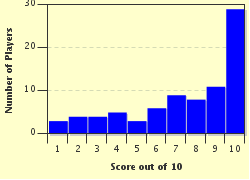Quiz Answer Key and Fun Facts
1. The wife of two kings and the mother of two kings, what formidable older woman in Act 1 of Shakespeare's "King John" asserts, "I am a soldier and now bound for France"?
2. The fictional character we first meet as Philip Faulconbridge is bluntly tagged "BASTARD" in the stage directions of Shakespeare's "King John"; however, he receives a different name when he is knighted. What name is he given, because he "hath a trick of Coeur de Lion's face"?
3. The young son of his older brother Geoffrey posed the greatest threat to King John's position as King Richard's successor. Named for a legendary king famous for the knights of the round table, who was John's fourteen-year-old nephew with a legitimate claim to the throne of England?
4. In Shakespeare's "King John" the mother of Arthur of Brittany is portrayed as on the verge of madness, wearing her hair down and screaming accusations, but she is constant and steadfast in her love and defense of her son. What name does this loyal mother appropriately have?
5. Shakespeare depicts King John's niece (a Castilian princess) and the son of King Philip II of France as being conveniently on the battlefield at Angiers when a royal wedding is proposed to seal a truce. What are the English names of the royal couple, who historically did marry and go on to be king and queen of France?
6. The Duke of Austria (Limoges) in Shakespeare's "King John" is a composite of two men in history: Leopold V, Duke of Austria, who held King Richard hostage on his way home from the Crusades, and Aimar V of Limoges, who was King Richard's enemy when the king was mortally wounded. What does the Duke of Austria in the play wear that causes "The Bastard" to target him?
7. Historically, Arthur of Brittany was imprisoned and eventually never seen again. In Shakespeare's "King John", Arthur's life ends when he jumps from the castle ramparts, seeking to escape having his eyes gouged out. Who has ordered Arthur to be blinded?
8. In Act 3, scene 1 of Shakespeare's "King John" the character Pandulph tells John, "by the lawful power that I have, / Thou shalt stand cursed and excommunicate" and anyone who rebels against John or kills him will become a saint. By whose authority does Pandulph make this pronouncement?
9. Who is taken out into an orchard to die in the last scene of Shakespeare's "The Life and Death of King John"?
10. In the final scene of Shakespeare's "King John" a character appears for the first time, the young prince who would become king after his father died. Who was this nine year old, who shared a name with his grandfather and with six additional kings of England, past and future?
Source: Author
nannywoo
This quiz was reviewed by FunTrivia editor
looney_tunes before going online.
Any errors found in FunTrivia content are routinely corrected through our feedback system.

